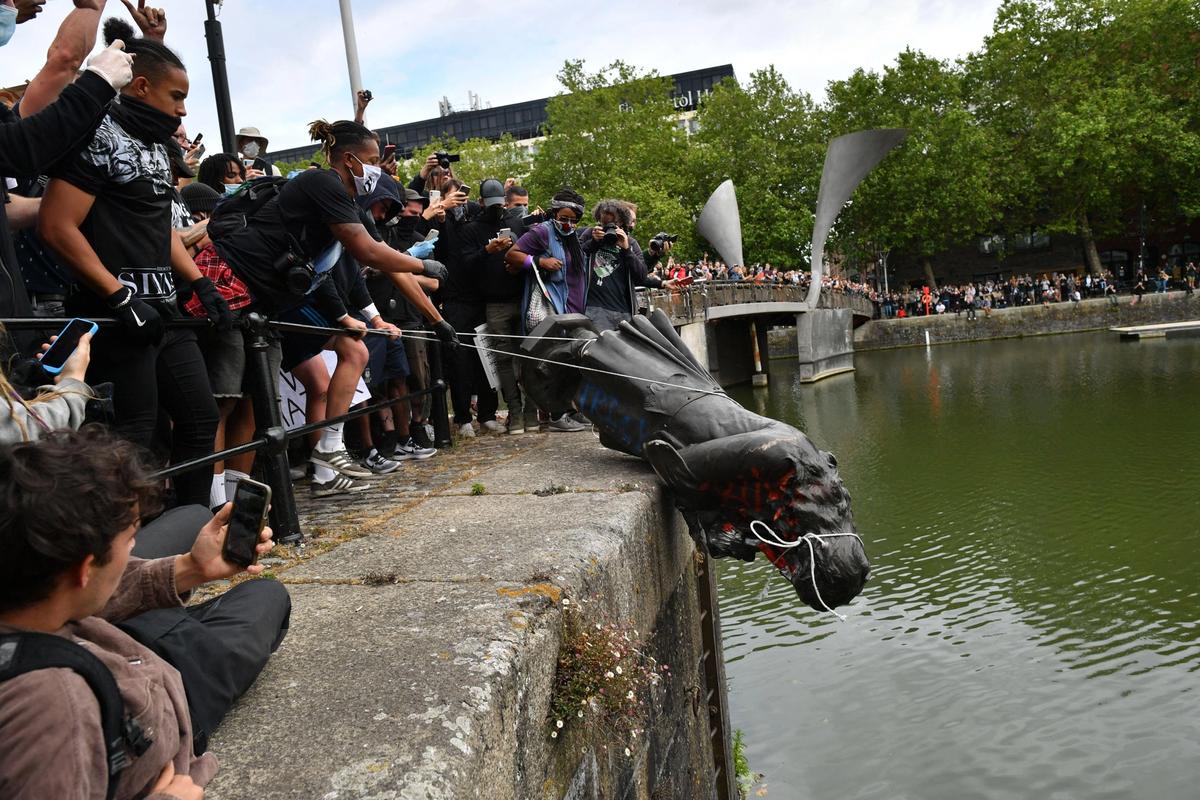Bristol's mayor Marvin Rees told the BBC this morning that the statue of the 17th-century slave trader Edward Colston may be placed in a city museum after it was toppled yesterday by anti-racism protestors following the death of George Floyd, and dumped in Bristol harbour. There are preliminary plans to raise the controversial monument from the water and display it along with protest placards laid around the sculpture plinth. The placards will be shown at the M Shed Museum, the mayor confirmed on twitter.
Rees said that the move is “part of an historical moment… [but] this is not condoning criminal damage… when events happen and they are big, they are historical; it is up to us to make sure that we record this moment for future generations to understand the journey Bristol has gone on.”
The British artist Hew Locke says the Colston monument, created by the sculptor John Cassidy, should be shown laying on its side at the local museum. “The sculpture is deeply problematic as he was such an evil man,” Locke says. “How you display it is important; footage of the work being thrown in the water could also be shown. It was a very sympathetic sculpture, he was posed like an enlightened man on the plinth. People will respond in a very different way if it is displayed horizontally.” Locke has focused on re-imagining Victorian statues as part of his practice.
The 18-foot bronze statue of Colston has long divided opinion in Bristol. Colston was a member of the Royal African Company, which dominated the West African slave trade, transporting around 80,000 men women and children from Africa to the Americas. The slave trader, who also cultivated a reputation as a philanthropist, died in 1721 though the statue was erected in 1895.
Professor Dan Hicks, the curator of archaeology at the Pitt Rivers Museum, University of Oxford, says that an immediate test for the UK heritage sector will be whether it is “bold enough to de-list the Colston statue—leaving it where it fell, underwater, or putting it in a museum store.”
Hicks, who recently wrote a book on the decolonisation of museums entitled The Brutish Museums (Pluto Press), adds that “communist and fascist monuments have been removed across Europe, but many memorials of colonial proto-fascism are still with us… People have been asking for Colston to be removed for decades. The museums and heritage sector has to learn from this moment if it is to understand what addressing institutional racism means for us.”
He adds that “Bristol needs to dismantle its other main monument to anti-blackness by returning the city museum’s Benin head looted from Nigeria in 1897 to the Royal Court of Benin”, bringing the issue of restitution to the fore. Curators at Bristol Museum & Art Gallery in the UK have said they will work with other museums in the so-called Benin Dialogue Group to try and resolve ongoing restitution issues linked to bronze artefacts looted by the British army in the late-19th century.
There are calls for other sites honouring slave traders to be re-named in the UK such as Sir John Hawkins Square in Plymouth. Asked if other problematic statues should be removed, Hicks says: “Transformative actions can take many forms, in some cases removals, but obviously this is about how communities feel and requires a case-by-case approach.”
UPDATE (10 June): Marvin Rees has announced that a new commission including historians and city placemakers will research and share "Bristol’s rich and varied areas and stories". The members of the commission will be announced at a later date.
The mayor also announced that the toppled statue of Edward Colston will be retrieved from the harbour and "exhibited in one of our museums", a council statement says. "The statue will be displayed alongside Black Lives Matter placards from the recent protest so the 300-year story of slavery through to today’s fight for racial equality can be learnt about."
The council has received proposals regarding what should go on the empty plinth, including another statue of a notable Bristol figure or revolving art projects. "The Mayor confirmed that any decision on how the plinth should be used will be decided democratically through consultation," the statement adds.


